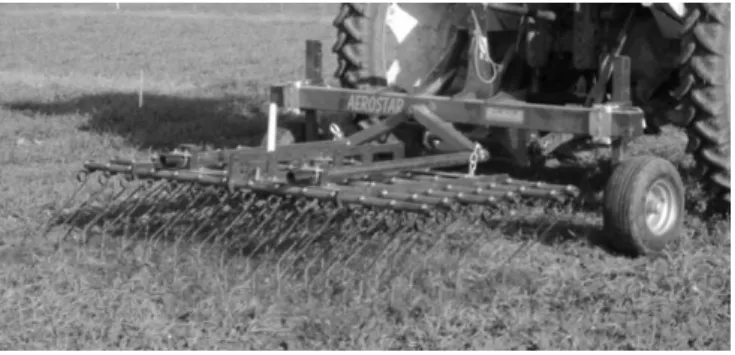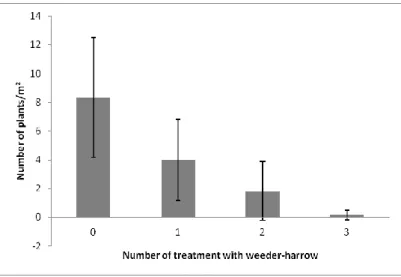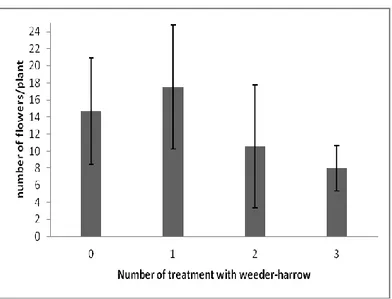Effect of mechanical weeding on wild chamomile (Matricaria chamomilla L.)
populations in winter wheat crop (Triticum aestivum L.).
D. Jaunard1, J-P. Bizoux, A. Monty2, F. Henriet3, M. De Proft3, F.Vancutsem1, G. Mahy2 & B. Bodson1
1: Unit of Crop management, University of Liège, Gembloux Agro-Bio Tech, Belgium 2: Biodiversity and landscape Unit, University of Liège, Gembloux Agro Bio Tech, Belgium
3: Plant Protection and Ecotoxicology Unit, Walloon Agricultural Research Center, Gembloux, Belgium
Corresponding author E-mail: delphine.jaunard@ulg.ac.be
SUMMARY
Currently, economic, agronomic and environmental concerns lead to reduce the use of herbicides. Mechanical weeding can help to reach this objective. Dynamics and biology of wild chamomile (Matricaria chamomilla L.) populations were assessed as well as dynamic of winter wheat (Triticum aestivum L.) for four level of application of a weeder-harrow (0, 1, 2, 3 treatment(s)). After each treatment, an effect of mechanical weeding on wild chamomile density was observed. Density of wild chamomile decreased significantly with intensification of mechanical weeding. A third treatment allowed eliminating late emerged plants.
Key words: wild chamomile, mechanical weeding, weeder-harrow, winter wheat, weed
management
INTRODUCTION
Weed management is essential in wheat production. Indeed, weeds are competing with crop for nutrient elements, light and water and can lead to significant yield losses. Their presence can also increase production costs or affect the harvest value because weeds can support development of pests and diseases, disturb harvest or influence wheat humidity rate (Jouy et al, 1998; Booth et al, 2003; Zoschke et al, 2002).
For decades, herbicides have been the main tool for weed control. Farmers have reduced the use of practical methods like tillage and rotation, and the study of weed biology have been relatively neglected (Buhler et al, 2000). But nowadays, concerns over environmental, human health problems and appearance of mechanism of resistance force authorities, scientists and farmers to promote and to develop appropriate weed management strategies that can help decrease amounts of herbicides applied. Old practical methods are credible alternative for weed control. In this context, it is relevant to enhance our knowledge of weed biology of main cereal weeds. It will allow to assess risks and consequences of their presence and to quantify influence of cultural practices on weed populations (Van Acker, 2009; Korres & Froud-Williams, 2001).
We studied dynamic of wild chamomile (Matricaria chamomilla L.) populations in a winter wheat crop (Triticum aestivum L.), in relation with application of mechanical weeding i.e. use of a weeder-harrow. A weeder-harrow is a tool composed of long flexible tines that uproots weeds. It can be applied on many crops (barley, wheat, beans, maize, rape...). To work more aggressively, it is possible to adjust tine angles, cultivation depth or even driving speed (Van Der Weide & al, 2008) (Figure 1). Treatment with a weeder-harrow should be made when the soil is sufficiently dried and the weather is sunny and warm. In winter wheat, it can have an impact on weeds with a development from emergence to two leaves (BBCH 12) when the wheat crop development is between one leaf (BBCH 11) to six leaves/ ear 1 cm (BBCH31) (Agro-Transfert, 2007).
Figure 1: Weeder-harrow used for mechanical weeding (source: Delphine Jaunard)
MATERIALS AND METHODS
EXPERIMENTAL SET-UP
Experiments were performed during the 2010-2011 growing season at the experimental farm of Gemblouw Agro Bio-Tech, Belgium. The field was located on a luvisol in agricultural region of Hesbaye. The previous crop was potatoes. Before sowing, seedbed was ploughed on a depth of 25 cm and then was tilled with a rotator harrow. Sowing of the winter wheat variety
“homeros” was carried out on November 25th
2010 with a seed rate of 375 seeds per square meter.
During spring 2011, experiment was arranged as a split plot design with four replicates. We studied two factors: intensity of mechanical weeding with a weeder harrow and presence/absence of chemical weeding (herbicide application). Four levels of mechanical weeding intensity were compared: 0, 1, 2 or 3 treatments with a weeder-harrow. In a replication, four plots were established on 14m x 4 m corresponding to each modality of mechanical weeding. The main plot was divided in two small plots (7 m x 4 m) corresponding to two modality of chemical weeding (presence or absence). Small plot contained an area for identification and count of weeds (2m x 5m), an area for yield quantification (2m x 5m) and an buffer area limiting spray drift (4m x 2m). Mechanical treatments with weeder-harrow were applied the 24th of March 2011, the 15th of April 2011 and the 26th of April 2011.
Herbicide treatment was applied on the 13th of April 2011. Products used were Verigal (1.2 l/ha), wich is an herbicide against annual and perennial broadleaf weeds containing 250 g/l
Bifenox and 308 g/l Mecoprop-p, and Othello (1.3 l/ha), which is an herbicide against grass and annual broadleaf weeds containing 50 g/l Diflunican; 2.4 g/l Iodosulfuron-Methyl-Sodium; 22.5 g/l Mefenpyr-Diethyl; and 7.5 g/ l Mesosulfuron-Methyl.
WILD CHAMOMILE DENSITY
M. chamomilla individuals were counted before and after each treatment with the
weeder-harrow and before crop harvest. Counting was realised in 6 delimited areas of 0, 25 m². These areas were located at the same place in each plot for all assessments. These data allowed estimating density of wild chamomile per square meter at punctual time.
WILD CHAMOMILE REPRODUCTION AND DEVELOPMENT
Reproduction rate was estimated in all plots without chemical weeding on five M. chamomilla plants. During the flowering period, number of inflorescences produced by plant was counted. Dry biomass, number of ramifications and total height of each plant was quantified too.
WHEAT YIELD
Wheat was harvested the 17th of August. For each plot an area of 10 m² (2 m x 5 m) was collected. The humidity rate was reduced to 15% using a drying oven in order to allow comparison between plots.
DATA ANALYSIS
A two-way ANOVA was carried out to assess the impact of weeding methods on wild chamomile population dynamics and wheat yield. Mechanical weeding intensity was crossed to chemical weeding and both factors were considered as fixed. Statistical analyses were done using ANOVA and General Liner Model (GLM) procedure of Minitab 15 software.
RESULTS
WILD CHAMOMILE BIOLOGY
In plot with chemical weeding, herbicide treatment had eliminated M. chamomilla and no effect of mechanical weeding were noted. In plot without chemical weeding, after each treatment with the weeder-harrow, we noted a decrease of wild chamomile density. In plots without treatment we also observed a decrease but this one is lower (30% against 94%, 100% and 89%, 21% and 33% against 78% and 54 %) and potentially due to natural competition by the crop . After the first two treatments, we noted emergence of new seedlings. Those were eliminated from plots with a third weeder-harrow use, contrarily to plots with no, one or two treatments (Table 1).
Tableau 1: M. chamomilla density (Plants/m²) before each treatment with weeder-harrow, reduction and percentage of reduction after each treatment (1st, 2d, 3d)) and cumulated effectiveness for each type of plots (with 0, 1, 2, 3 treatment(s)) (plots without chemical weeding).
plants/m² % of reduction (-) plants/m² % of reduction (-) plants/m² % of reduction (-) plants/m² % age no mech. weedings 5,00 -1,50 -30 7,83 -1,67 -21 6,17 + 3,00 + 49 + 3,33 +67 1 mech. weedings 5,50 -5,17 -94 1,00 -0,33 -33 0,67 + 0,67 + 100 -1,50 - 27 2 mech. weedings 4,17 -4,17 -100 1,50 -1,17 -78 0,33 + 0,67 + 200 -2,33 - 56 3 mech. weedings 6,17 -5,50 -89 2,17 -1,17 -54 1,00 -0,50 -50 -6,00 - 97 N o n Ch . W Wild chamomile 23thof March 2011 (plants/m²) 13thof April 2011 (plants/m²) 20th of April 2011 (Plants/m²) Reduction after first
treatment
Reduction after second treatment
Reduction after third treatment
Cumulated effectiveness
Density of wild chamomile measured in plots before crop harvest decreased significantly with intensification of mechanical weeding (Figure 2).
Figure 2: Density of wild chamomile (plants/m²) in each type of plots (0, 1, 2, and 3 treatment(s) with weeder-harrow) in July 2011
There was no significant effect of mechanical weeding on the mean number of flowers produced per plant. Nevertheless, we observed a light decrease from one treatment with weeder-harrow to three treatments (Figure 3).
Figure 3: Mean Number of flowers produced per a wild chamomile plant in each type of plots (0, 1, 2, and 3 treatment(s) with weeder-harrow)-July 2011
WHEAT
As well in plots with chemical weeding as in plots without chemical weeding, use and intensification of mechanical weeding did not have significant effect on mean yield; while, we observed a significant effect of herbicide application. In plots with chemical weeding, yield was lower than in plots without chemical weeding (less 260 kg to 500 kg/ha).
CONCLUSIONS
Growing season 2010-2011 met all climatic and agronomic conditions for application of mechanical weeding. In these conditions, use and intensification of mechanical weeding have a significant effect on density of wild chamomile plant. Successive application, can allow the elimination of late emerged weeds. Moreover, the use of weeder-harrow does not seem to affect wheat yield. Mechanical weeding appears like a promising method to reduce wild chamomile population under agricultural conditions of central Belgium. To confirm these results, experiments are under investigation this year in similar conditions.
ACKNOWLEDGMENT
This work was supported by Direction Générale opérationnelle de l’Agriculture, des Ressources Naturelles et de l’Environnement (DGARNE) du Service Public de Wallonie (SPW). We thank them for their contribution. We also thank staff of Plant Protection and Ecotoxicology Unit (CRA-W), Crop management Unit and Biodiversity and landscape Unit for their assistance.
LITERATURE
AGRO-TRANSFERT RESSOURCES ET TERRITOIRES-PÔLE SYSTEMES DE
CULTURES INNOVANTS (2007). La herse étrille-Fiche technique.http://www.agro-transfertrt.org/index.php?tsearch=1&option=com_docman&task=search_result&start=0&dm_ keyword=18.
BOOTH B.D., MURPHY S.D., SWANTON C.J. (2003). Weed ecology in natural and
agricultural systems. Cambridge: CABI publishing
BUHLER D.D., LIEBMAN M., OBRYCKI J. (2000). Theoretical and practical challenges to IPM approach to weed management. Weed Sci., 48, 274-280.
BUHLER D.D. (2003). Weed biology, Cropping Systems, and Weed Management. Journal of Crop Protection. 8: 245-270.
JOUY L. ET GUILBERT F. (1998). Influence des pratiques culturales sur l’évolution de la flore adventice en grandes cultures. XVIIe Conférence du Columa, Journées d’études sur le désherbage, Dijon, 79-90.
KORRES N. E. & FROUD-DOUGLAS R.J. (2001). Effects of winter wheat cultivars and seed rate on the biological characteristics of naturally occurring weed flora. Weed research.
42: 417-428.
VAN ACKER R.C. (2009). Weed biology serves practical weed management. Weed research,
49 : 1-5.
VAN DER WEIDE R.Y., BLEEKER P.O., ACHTEN V.T.J.M., LOTZ L.A.P. ; FOGELBERG F., MELANDER B. (2008). Innovation in mechanical weed control in crop rows. Weed research 48, 215-224
ZOSCHKE A. & QUADRANTI M. (2002). Integrated weed management: Quo vadis?. Weed biology and Management. 2: 1-10.


